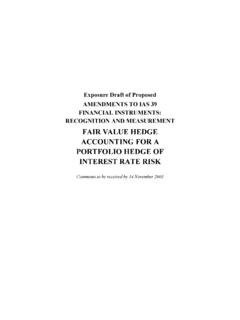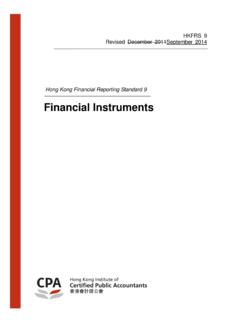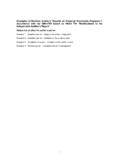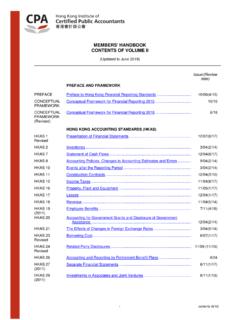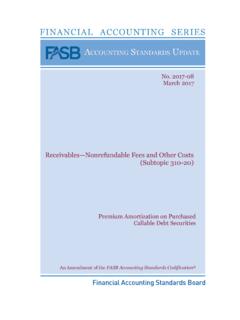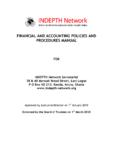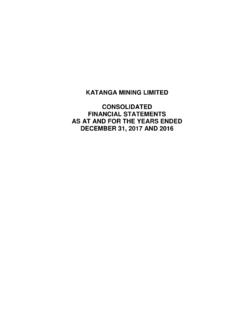Transcription of Accounting Guideline 1
1 AG 1. Issued March 1984. Accounting Guideline 1. Preparation and Presentation of Accounts from Incomplete Records AG 1. COPYRIGHT. Copyright 2008 Hong Kong Institute of Certified Public Accountants This Accounting Guideline contains Hong Kong Institute of Certified Public Accountants copyright material. Reproduction in unaltered form (retaining this notice) is permitted for personal and non- commercial use subject to the inclusion of an acknowledgment of the source. Requests and inquiries concerning reproduction and rights for commercial purposes should be addressed to the Director, Operation and Finance, Hong Kong Institute of Certified Public Accountants, 37/F., Wu Chung House, 213 Queen's Road East, Wanchai, Hong Kong. Copyright i AG 1 (March 1984).
2 AG 1. Accounting Guideline 1. PREPARATION AND PRESENTATION OF ACCOUNTS. FROM INCOMPLETE RECORDS. Part 1 - Introduction 1. Accountants are all too often faced with the problem of preparing accounts from incomplete records. The following statement relates to the preparation and presentation of accounts from incomplete records and the submission of such accounts to third parties. The statement refers primarily to business undertakings, but may also be applicable in appropriate circumstances to the accounts of various types of non-trading concerns. 2. It is hoped that for those engaged in this type of work this statement may be useful as a summary of considerations which should be kept in mind when preparing accounts from incomplete records and of procedures which have been found helpful in practice.
3 Part 2 - Definitions 3. Incomplete records means the state of affairs which exists when there is lacking some or all of the prime Accounting information from which in the normal way the books of a business are written up and final accounts prepared. It is not, for instance, applicable where an adequate system exists for supplying the accountant with information in a suitable form for writing up his client's books or otherwise collating the essential information and subsequently preparing final accounts. Part 3 - Recommended Practice 4. The scope of the work undertaken by the accountant is governed by his client's instructions, unless the work involves the audit of the accounts of a limited company. Although the accountant is rarely required to audit accounts prepared from incomplete records, auditing procedures such as vouching and verification are employed as far as possible to ascertain basic information and ensure that items are properly treated in the accounts.
4 The greater the extent to which these procedures are employed, the greater will be the reliability of the accounts and the degree of responsibility which the accountant may assume in respect of them. 5. When accepting new work involving incomplete records it is desirable to observe the normal professional precaution of confirming instructions in writing and defining the scope of the work to be carried out. Sometimes instructions are, however, necessarily vague because the scope of the work which can be performed cannot be determined until a detailed examination of the business and its records has been carried out. In this case it is desirable to report on the work done when submitting the accounts to the client or at some other suitable time.
5 Copyright 1. AG 1 (March 1984). 6. Accounts prepared from incomplete records are normally required for a specific purpose, such as taxation, probate, negotiations for sale, or in support of requests for loans or bank overdrafts. Sometimes, however, they are put to uses other than those originally intended. Whatever the purpose for which the accounts are prepared or the use to which they may be put, the accountant's primary duty is towards his client and his main object in preparing the accounts is to show, so far as practicable in the circumstances, a true and fair view of the trading results for the period under review and of the state of affairs of the business at the close of the period. 7. The accountant may not know the eventual uses to which accounts may be put, or the extent to which they may be relied upon in the formation of opinions by third parties.
6 It is therefore most important that accounts should carry a statement clearly defining the extent of the accountant's responsibility for the figures, expressing any opinion which he has been able to form on their adequacy and noting any significant limitation to their reliability. The appropriate form of report is illustrated in the Auditing Guideline No. "Audit report examples". It is always desirable, and where accounts are being submitted for tax purposes essential, to obtain the client's signature to the final accounts, as evidence that they have his approval. 8. On first being instructed to prepare accounts from incomplete records the accountant will be restricted to such information as his client can make available, or he himself can obtain, but at the same time he should endeavour to suggest improvements that will make his task in future lighter, by introducing some system, no matter how rudimentary, that will provide as much as possible of the basic information required.
7 The essence of any proposed system must be simplicity, and its form will depend on the circumstances of the business and the willingness and ability of the proprietor to assist. Every effort should be made to persuade the client to improve his records, particularly those relating to cash receipts and payments, and it should be made clear that accounts prepared from incomplete records cannot be regarded as wholly reliable and must consequently be limited in value to the client. It is essential to stress the importance of keeping purchase invoices, copy sales invoices, receipted accounts, paid cheques (where available), cheque book counterfoils and bank paying-in books and statements. A. common form of omission which clients should be asked to rectify is the failure to include sufficient detail on bank paying-in slips to identify the items concerned.
8 Preparation of accounts from incomplete records 9. The steps in the preparation of the accounts of a trading concern from incomplete records may be summarised as follows: (a) drawing up an opening balance sheet where one is not available;. (b) preparing summary cash and bank accounts;. (c) scheduling debtors and creditors;. (d) ascertaining, in consultation with the client, that the amount at which stock is to be stated appears reasonable, having regard to the nature of the trade and the circumstances of the business;. (e) making year end adjustments for provisions, transfers, etc.;. (f) preparing the final accounts from the information thus assembled. Copyright 2. AG 1 (March 1984). Summary cash and bank accounts 10. Before beginning to build up and analyse the summary cash and bank accounts, it is important to obtain the client's assurance that he has made available all the requisite information pertaining to his business, and that no business receipts or expenses have been passed through other bank, deposit or petty cash accounts.
9 Failing this, it is desirable to examine such other bank statements. 11. The adequacy of the final accounts depends largely on the care with which summary cash and bank accounts are prepared. Normally at least some records are available (bank statements, some vouchers, possibly a cash book) but by definition they will be incomplete because either (a) items have been recorded but are unexplained and unsupported, or (b) items have been wholly omitted. 12. Any unexplained items remaining after analysis of the bank statement require examination to determine whether they relate to private or business transactions and in the latter case whether these are capital or revenue. Payments into the bank should also be scrutinised to ensure that any non-trading receipts such as dividends, rents from private properties or capital items are segregated from trading items.
10 Unusually large receipts or payments will generally stand out clearly from the normal level of trading items, and will prompt inquiry. They may be attributable, inter alia, to the introduction of new capital, loans or the realisation of business assets, or, if they are outgoings, to loans, purchases of new equipment, or personal drawings. 13. In preparing the summary cash account the usual procedure is to attempt to reduce the likelihood of omissions by inquiring into those payments which are known to be of a recurring nature. Some are fixed or semi-fixed in amount and may be readily accounted for: rent, rates and insurance, for example, or in some businesses, wages and salaries. Other payments, while variable, are known to recur, and omissions may be remedied by inquiry or reasonable estimate.

